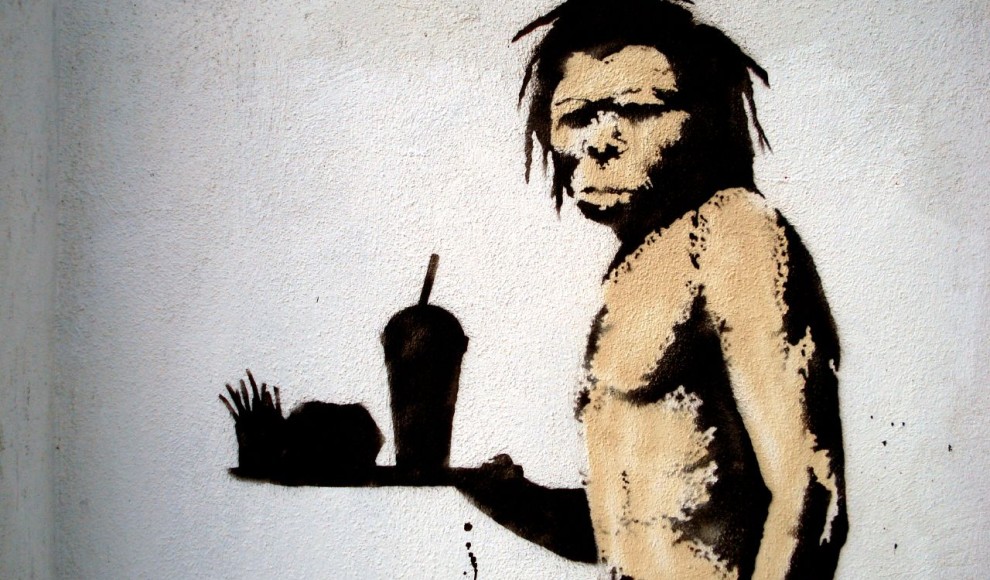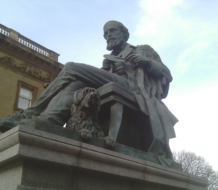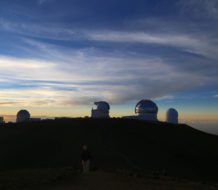The answer to this question depends on what we mean by “science.”
If we are interested in what the sciences of chemistry or physics tell us then there is very little, if anything, that is unique about humans relative to other living things on the planet. If we are interested in molecular biology, we end up in almost the same place, as there is almost nothing unique about the molecules that make us up. However, when we start to ask questions about the science of human evolution, some distinctions begin to emerge; the whole is greater than the sum of the parts.
The evolutionary history of human bodies and behavior suggests that humans cooperate, coordinate, create, destroy, imagine, believe and hope in ways that are distinctive from the rest of the world.
Evolution is change over time and it results in two key patterns: continuity and discontinuity. Shared ancestry gives all life continuities. Those with more recent shared ancestry (like humans and apes) share more in common than those with more remote shared ancestry (like humans and codfish). When talking about evolution most people focus on the continuities. Humans and the other primates, even many social mammals, share much in common: we come from the same ancestral lineages, our bodies work in very similar ways, we care for our young, form strong bonds with one another, and navigate complex social lives via friendships and fights. In these contexts humans are not at all unique.
The discontinuities, however, are a different story. Although our chemistry and molecules are not different from those of other animals, the way they have been shaped over the course of our evolution produces a system (our bodies/minds) that has a much wider range behavioral options, capacities, and flexibility than most others. We have a distinctive ability to bring our bodies/minds together to shape the world around us. Many animals cooperate (ants, scrubjays, meerkats, etc…), many impact the environment (beavers, termites, earthworms, etc…), and some are certainly self-aware (apes, elephants, whales, etc…), but none combine these elements with the intensity, scale, and complexity that humans do.
In the time since our line split with the line of African apes (about 8 million years ago), and especially since our genus (the human lineage, Homo) emerged and began to spread across the globe (around 2 million years ago), humans have become a particularly distinctive, maybe even unique, presence on this planet.
The earliest members of the our lineage were little fangless, hornless, clawless ape-like beings, living in small groups in the forests and savannahs of Africa…where there were a lot of very large predators. Our ancestors had no natural weaponry, but they had something better: each other.
Together they created stone, wood and bone tools and developed new ways to use and modify the landscape. They were able to avoid predators, to hunt, to create and use fire, to trade with, fight, and make alliances with other groups, and to expand their range across the globe meeting the challenges of every new environment they encountered. They did so by making cooperation more than just working together—they thought together, shared ideas, developed solutions, taught one another, and took risks that are only possible when you know that you are not alone.
The human adaptive niche (the way we live in the world) is one of cooperating, coordinating and creating. This gives us the context to understand how our indistinctive molecules and chemistry became distinctive biology and behavior.
Take our brains, for example. Humans have large brains relative to our body size, and while that is rare in the animal kingdom, it is not unique. What is distinctive is how our brains develop and how we use them. Humans have the longest and most dependent childhood of any animal—and we need it. It takes an amazingly long time to learn even the basic information, skills and processes we need to successfully be a member of a human community.
At birth, the human brain is woefully underdeveloped leaving the infant completely defenses for years. Because of their defenseless and slow development, human infants have an extreme need for social and physical interaction, thus humans need a lot of help in raising offspring. We are what researchers call cooperative breeders—evolutionary science tells us that it really does take a community to raise a child.
The infant’s brain and the rest of the body grow at a similar pace until about 2 years of age when the brain hijacks the lion’s share of the energy and grows at a startling pace for the next 5 years or so. This is also when the young human is learning the core complexities of life: language, gender, morals and ethics, social expectations and cultural mores. It is also the time when the young human is learning to use their body to walk, run, laugh, play, hide, seek, etc…
Our bodies and minds develop in concert, intertwined and shaped by the social, material and symbolic contexts in which we mature. These processes are seen in the ways we react to getting along, to fighting and to making up. Our hormone systems, the activity of our brains and the ways in which our immune systems and digestive physiology’s work shape, and are shaped by, this distinctive human niche.
Cooperation is at the very heart of our species’ ability to reproduce and living in a community of self-aware and collaborative individuals is a central component of our species’ long, slow social and biological development. To do this well, in the past and today, we have had to become a particularly creative species. Without natural armaments to defend themselves, our ancestors had to innovate ways to work together and to use the world around them by altering it. They did (and we do) so by making plans, and strategies, by negotiating conflicts and collaborations, by making make tools, shelters, clothes, villages farms, towns and cities. But this creativity does not only come from single ideas. It comes from individuals getting together and sharing ideas and thoughts and working together to make them happen. Humans do not shape the world individually, we shape it together as a community.
As humans became more and more reliant on creativity, innovation and cooperation to make it in the world, our sharing of ideas, our abilities to communicate them and our capacities to manipulate the world around us created a novel context, a conflux of processes not seen in other organisms, which produced one of the most distinctive patterns of humanity: imagination.
Imagination is the ability to exist in a perceptual reality wherein everything—be it trees, colors, foods, daily routines, social relationships, etc.—is infused with meaning that goes beyond the material items, beyond the specific actions, beyond the tangible at-hand experience. As early as ~300,000 years ago we find archeological evidence of this imagination: lines traced on pieces of ochre or shells and beautifully symmetrical stone tools that were made but never used. In the last 120,000 years we find carved figures, shell necklaces, cave paintings and murals– evidence of a full-blown human imagination.
And from this imagination, in the context of our fundamental patterns of cooperation and creativity mixed with our self-awareness, sprung distinctively human processes of belief and hope. In humans, hope is the use of the imagination to provide individuals, and communities, with stimulus and justification to undertake actions or endeavors with wholly unpredictable outcomes or that under normal conditions of predictability would be interpreted as leading to failure, danger or even death. Hope enables us to be even greater at creativity and cooperation. Belief emerges from the interface of imagination and hope. The history of humanity, especially over the last ~12,000 years, demonstrates that the development and spread of major systems of belief (faiths, moral systems, political and economic ideologies, etc…) has had a great hand in shaping the distinctive landscapes and societies of the world today.
Unfortunately, all of the elements that have enabled humans to beat the evolutionary odds and be such a successful species (our distinctive human niche) can also lead to what might be a truly unique capacity of our species: cruelty and intentional destruction.
Other animals kill and eat one another, at times in a gruesome fashion…sometimes with premeditation and even elation. However, no other species is capable of combining cooperation, creativity and imagination towards intentionally making others suffer, even in the absence of specific material reward. We can, unlike any others on this planet, coordinate and willfully and creatively cause great suffering to others, to landscapes and even to entire ecosystems. And we sometimes do so with alarming efficiency.
So what does science suggest about human uniqueness? It suggests that we are complex, cooperative, creative and imaginative beings whose bodies and minds have amazing aptitudes for caring, understanding, hoping, believing and for reshaping the world around us and that these same skills give us the capacity for willful cruelty and destruction. It is up to us to decide what to do with what science suggests.
Discussion questions:
- How do this essay’s assertions fit with arguments for a very strong role of genes in controlling/influencing human behavior?
- If we are so cooperative, creative and imaginative are we a species that has outgrown the constraints of biological evolution?
- Does this mean that cruelty is part of human nature?
- How do we know that apes, whales and elephants aren’t creative and imaginative and humans?
- Can the concept that the potential for belief emerges over our evolutionary history fit doctrines and philosophies of world religions?
Discussion Summary
In response to the question “What Does Science Suggest About Human Uniqueness?” I answered that what we know from a scientific approach to human evolution suggests we are complex, cooperative, creative and imaginative beings whose bodies and minds have amazing aptitudes for caring, understanding, hoping, believing and for reshaping the world around us. I also cautioned that these same set capacities give us the ability for willful cruelty and destruction. I concluded that it is up to us to decide what to do with what science suggests.
The responses to my essay varied but settled on a few key topics: How much do we actually cooperate? Are humans innately aggressive or warlike? And, how can we best think about a human imagination? I’d like to expand just a bit on these thoughts and close with a few options for future Big Questions that stem from these musings.
There is a broad set of behavioral and evolutionary literature supporting the notion that cooperation is core in human societies. It appears that cooperation and shared information exchange, combined with socially negotiated distribution of labor, effectively coordinates large groups of people. The case for cooperation as central to human success has been made for human ancestors, modern humans in simple foraging societies, agriculturalists, and modern nation states. There is copious fossil and material evidence that early on in our evolutionary history increasing the ways in which we worked together as opposed to selfish and individually based behaviors is what enabled humans to spread far and wide across the planet. There is also a large body of evidence that demonstrates that agriculture, village and city structures, large scale religious organizations and political systems, trade and market economies all rely on a substantial infrastructure of human cooperation for their success: simply put, cooperation is what humans do best and what makes us such a successful species. This does not mean that competition and conflict are not also common, they are. It is just that they are not the basis for our success as a species. Aggression can emerge out of cooperation, or the breakdown of cooperation, but nearly every study conducted on human social behavior indicates higher frequencies and greater emphasis on cooperation than any other single behavioral pattern.
But what about aggression in human evolution?
In the human fossil and archeological record there is no good evidence of intense, frequent inter-individual aggression or warfare until recently (the last ~14,000 years), and it is associated with the advent of settlements, agriculture, and social stratification. Increased social inequality and more complex political and economic systems seem to correlate with more types of, and a higher frequency of, coordinated aggression and violence in human societies. Interestingly, these same scenarios also correlate with larger and more complex peaceful relationships amongst and between peoples- peace and war are not opposites, they both emerge from the same human capacities.
Humans can, and do, engage in a wide variety of aggression. However, aggression is not our primary “go to” behavior as successful organisms. There is insufficient evidence to argue that we have evolved a suite of specifically aggressive behaviors to succeed in the world. It is largely our abilities to get along and to negotiate complex social problems, with and without aggression, that make humans one of the most successful species on this planet.
Finally, a key to understanding human success lies in the realization that the human imagination is distinctive. A significant component of human distinctiveness is our being a species where symbol and profound meaning are central to our lives. The ways in which symbols are generated, perceived and utilized structure our perceptions and behavior such that the “material” world is never without symbolic contexts. This influences how we interface with the challenges and affordances the world around us offers. Humans exist in a landscape of meaning, where our way of being arises from the interactions of many elements (bodies, brains, senses, perceptions, experiences, other beings, etc…) but that none of these have in themselves the specific property of symbolic experience–it emerges from the interrelationships of these components. This process creates our species’ distinctive imagination.
Given what evolutionary science tells us about humans, two interesting big questions emerge for future conversations.
New Big Questions:
1) Can we use the human propensity to cooperate and coordinate to tackle current social ills generated by inequality and injustice?
2) Can a deeper understanding of the human imagination move us towards new avenues for dialogue between religious faiths?












But, is there evolution if there is no time? How will evolutionary biology meet new physical paradigms about time, space and so on? Will new conceptual changes deny evolution? Or on the contrary, will it become a more extraordinary process, full of astonishing implications? If so, will past human beings and the rest of living beings become something different as science progresses? Beacause, is life something fix-finite-defined? That is, can one understand it by means of using a flesh brain and its limited words, axioms and dogmas? Does the whole of life fit inside a word, inside a bone box? Indeed, will science add ndefinitely without understanding completely, is there an infinite pool of knowledge and ignorance waiting for us? Along these lines, there is a different book, a preview in http://goo.gl/rfVqw6 Just another suggestion in order to freethink for a while.
Are we as cooperative as the original article proposes? We clearly show various degrees of cooperative behavior – high levels of cooperation within our tribe, and lesser degrees of cooperation dependent upon the level of relatedness we perceive between our tribe and other tribes. And yes, we are very tribal, although today we might use other words, such as nation or race or religion. I find the word “cooperation” problematic, because we don’t show cooperation widely. We reflect cooperation only in so far as we imagine it will benefit us. Cooperation within the family and immediate tribe is secure in benefitting our own interests; cooperation with an outside tribe secures us very little benefit, especially if we are in direct competition for certain resources. In a sense, we are still faced with Malthus’ problems and Adam Smith’s analysis of economic interest, leaving simple answers vulnerable to argument.
And I find intelligence a difficult argument to make as any form of significant evolutionary benefit. While intelligence as given us greater harvests and greater delivery of those harvests to increase our population, intelligence has also given us greater capabilities to exterminate ourselves and the vast majority of lifeforms on the planet. Considering that we are an evolutionary outlier, it is difficult to say if intelligence is a truly successful evolutionary adaptation, or merely another “experiment” that may prune itself off the tree of life.
For a “social” species, we seem to be barely social, and for an “intelligent” species, we don’t seem to be intelligent enough not to poop in our own nest. As a species who has only a 6,000 year history of our accomplishments written down – about 300 generations? – it is hard to really say how our evolutionary development will play out. I would like to be optimistic, but the last 15 generations have not shown us any more advanced toward eliminating our belligerent nature, which yet may be our defeat.
There is a good point here about how much do humans really cooperate outside of their own groups (however we define those groups). The actual answer is: quite a lot. Culturally, we often focus on conflict between groups, but if you look carefully at both deep history and more recent times, you see an incredible amount of cooperation between different groups, even in some of the most complex and difficult situations. We are a supremely social species, our everyday actions bear that out. We take for granted, and even expect, a headline that reads “4 killed in New York City today.” But the one that is much more common and much more reflective of the daily lives of humanity is “7, 999,996 people got along today in New York City.” But we never see that one, even though it is by far the more common actual occurrence. Malthus did not envision a species as creative and collaborative as us in his model and Adam Smith’s notion of individual economic interest, while an important aspect of our modern philosophical history, misses the data in support of a critical role for groups and cooperation in our species evolutionary history.
Across the planet you see collaborations between different ethnic groups, between pastoralists and agriculturalists, between groups of differing religions and even languages as the norm, with violent conflict being present but not as often as cooperation. In the deep past we see evidence of trade routes spanning hundreds of miles and many groups, ideas, items and individuals flowed between these groups establishing bonds and creating deep alliances. More recently we see centuries old relationships between forest foragers and pastoralists, each providing specific goods and services to the other, sometime intermarrying and sharing families. Closer to modern times we see communities, even nations, collaborating on projects, in alliances and in humanitarian efforts. Think of the recent multi-national efforts in response to natural and human –made disasters, and even the cooperation between nations in warfare. We nee dot look past the headlines and the tendency to focus on violent conflict and actually look to the data for what humans mostly do day in and day out.
Great essay, Augustin. Thanks!
I wonder if you might discuss two questions. First, the earliest human cooperation was very likely among kin groups. Or am I wrong? Kin cooperation is not hard to explain evolutionarily. When did humans start cooperating with non-kin and what was the conflict/cooperation ratio then? I assume it’s not like the figures for NYC today. And what were the evolutionary mechanisms involved in increasing that cooperation?
Second, what role do you think religion played in encouraging cooperation? Confrontation? You know of cognitive science of religion, supernatural punishment theory, CREDS and all that. What’s your take?
Thanks for the great questions Kelly. It is most likely that the early human groups were largely kin-based, but we know next to nothing about the transfer patterns (that is who left and who entered the groups and what kinds of exchanges went on between groups in any given area). It might have been like chimpanzees where females often leave the groups they were born into and move to new groups, or like macaques where the males leave or even like many other primates species where both males and females leave the groups they are born into. So we do not know how related all members of a given group were at any given time. Interestingly, relatedness explains less about cooperation than we thought in many primates. For example, male chimpanzees’ main alliance partners are more often their age mates than their close relatives.
Evidence of conflict or cooperation between groups is scant early on. But it is possible that early humans cooperated extensively with non-kin and even across groups fairly early on. There is pretty good evidence of the transfer of raw materials for stone tools over 20 miles more than a million years ago, which might suggest some possible collaborations and/or tolerances between groups in a region. There is also a range of evidence from tool making and butchering sites that suggest some pretty intensive cooperative behavior.
As for evolutionary mechanisms for increasing cooperation, there have been multiple recent arguments invoking Niche Construction, multi-level selection and even group-cultural selection.
The religion questions is certainly a hot-ticket point of discussion now. Almost everyone agrees that large-scale religion does a very good job of organizing humans, and I think no one would argue against the assertion that religion can also create a context, and conduit, for potential conflict. This is a much longer discussion than is possible in a brief response and I recommend a recent set of review articles in the journal Religion, Brain and Behavior (4(3) 2014) as a good place to see a diversity of views on this topic (including mine). A summary of my point would be that yes religion can serve those functions, but religion itself is neither an evolved trait nor simply an adaptive complex of characteristics and practices. There is much more to religion and the religious experience.
This is a remarkably perceptive and well reasoned article. It reflects many of the viewpoints expressed in my own writings and certainly stands out from the crowd. I particularly liked the avoidance of the vague, silly and often emotive word “intelligence” which usually creeps into such discussions and is responsible for much of the wooly thinking which, sadly, is so rife.
Replacement by the use of the much more meaningful word “imagination”, technically defined as the ability to form, store and morph neural representations of the environment as provided by sensory receptors, is a far more useful concept. It is also not too far from the everyday use of the term.
The uniquely sophisticated human imagination can certainly generate images, constructions,acoustic sequences and concepts that it has not previously encountered. Paintings by Salvador Dali, the Eiffel tower, the works of Shakespeare, the music of Mozart, the Unicorn, the notion of a multiverse are some examples.
On the other hand we can quite safely say that the elements of all these have been encountered before, either directly or as a result of transmission by language. Our particular imaginations have developed the ability to blend, morph and reconfigure these elements in many ways.
That is our special quality. The imaginations of other animals, even such as cats, dogs, chimps and birds come nowhere near to this. They have their own special capabilities which have evolved to match their particular ecological niches. The dog, and the salmon have incredible olfactory selectivity and sensitivity respectively. The octopus needs its big brain to be able to perform the extraordinary task of matching its skin colors and textures to the terrain. The elephant to control, as well the innervation of a very large body andexceptional olfactory capability, that extraordinary sensori-motor organ, the trunk.
But when it comes to sheer imaginatory power, no creature comes within a bull’s roar of that of the human. So how has that feature evolved?
The answer to this question harks back to the divergence of the hominids from the ancestors of the gorilla and the chimpazees. Agustin notes that we are “fangless, hornless and clawless” but ufortunately misses the far more significant point that we are snoutless. And it in fact this crucial transition, the adoption of the hands rather than the snout for acquisition and pre-processing of foods which ultimately led to the co-evolution of imagination with its correlate language. Language, in contast to mere communication being defineable as the import, export and external storage of imagination. A feature to which almost all the unique features of human behavior are attributable. One exception is our notable belligerence, which can be plausibly argued to play another part in our particular evolutionary history.
There is far more to be said, but rather than “re-inventing the wheel” I will simply refer the reader to my latest book “The Intricacy Generator: Pushing Chemistry and Geometry Uphill” in which will be found more ezhaustive discussion of this and related issues.
However,to briefly address the questions posed at the end of the article:
a) The role of the gene in determining behavioral characteristics is, in fact, grossly exaggerated.
It is a serious and very common mistake to believe that the characteristics of organisms are determined solely, or even for the most part, by DNA. So while there is some truth, and certainly much of interest in Xu’s reply, it is far from the whole story. The genome is actually just a rather small library of protein recipes. It is entirely passive. It is actively manipulated, maintained and accessed by RNA and other cellular machinery.
Enzymic machinery, together with support structures and organelles such as mitichondria that are already inherited DIRECTLY by cell division, and only supplemented by the manufacture of additional machinery of the same kind. With, of course, the mixing and matching of protein recipes which is characteristic of the sexual mode and safely adds diversity.This network model of inheritance and morphogenesis is explained more fully in chapter 11 of The IntricacyGenerator.
b) To some extent, yes. And we must bear in mind that a new phase of the evolutionary process is now with us. That of technology. Which, contrary our usual intuitions, is properly interpreted as an autonomous process occuring in the medium of our collective imaginations.
c) As mentioned above, the answer is essentially yes! However, it is a feature that is now “past its use-by date” and the careful analysis presented by Steven Pinker in his book “The Better Angels of Our Nature” suggests that it is fortunately on the wane.
d) I argue that most, if not all “higher” animals require some degree of imagination. Further that all organisms require some degree of consciousness (self-awareness). I also argue, with plenty of evidential support, that “creativity” in any species, including our own, is largely illusory.
e) The emergence of such belief systems, which I interpret as the precursors of science and also as “well past there use-by date” is the subject of chapter 15 of The Intricacy Generator.
The above comment is not to be reproduced without attribution or edited without permission.
Thank you for these interesting comments Cognosium. I wholly agree with your thoughts on intelligence and imagination. I also like that you point out the reduction in olfactory focus in our lineage.
I would contextualize your assertion that cruelty is part of human nature…I prefer to see it as part of human potential. That is, it is not what lies at the heart of our success as a species but is certainly a potential (and maybe even probable) outcome of it. I also caution your assertion about Pinker’s conclusions. Pinker makes assumptions about the rates and severity of violence in the human deep past that are absolutely not borne out by the available data (see recent work by Matthew Piscatelli and overviews by Douglas Fry and Brian Ferguson for those data). The human history of warfare and organized violence is neither a pervasive nor as clear as Pinker asserts it is.
Finally, I am not sure I understand what you mean when you say that “creativity” is largely illusory. Are you referring to the process of creating? The perceptual states, shared intentionality, communication and actions that accompany creativity? Or the concept that “creativity” itself is something that is detached from the material and/or experiential context (which I do not think is true).
Thanks for bring up these points, Agustin.
My assertions regarding the evolutionary “benefit” of belligerence actually apply to intra-species conflict rather than cruelty per se. The following extract from “The Intricacy Generator” gives the gist of my reasoning”
A distinguishing behavioural characteristic of homo sapiens, as far as we can trace it back, is intra-species warfare. Sure, this occurs within other mammals to some extent, but none of these displays anywhere near the level of belligerence towards its own kind that is displayed by humans. Again, the inadequacies of the fossil record leave us uncertain of the era in which this trait originated. Certainly, the Pan variety of the chimpanzee can be fairly aggressive, but five million years of very different adaptations have occurred since our lineages parted company, so we can’t assume the trait to be derived from a common ancestor. Any more than we assume the generally pacific mode of the Bonobo to be derived from that of the Gorilla. From an engineering perspective we can only say that the establishment of this feature provides the positive feedback potential for an “arms race” to flourish. Particularly in synergy with the development of tertiary tool use. In the light of which we could fairly safely pin it down to the era in which an explosive encephalisation event appears to have taken place.
I have encounterd some dissent from Pinker’s stance and also some conflicting support, but will be interested to perhaps review my opinions in the light of the sources you have mentioned.
My argument regarding the illusory nature of creativity is dealt with in the context of the inventor in chapter 17 of TIG but it appies equally to other aspects of creativity.
The realization that the evolution of technology and its congenors is an autonomous process that occurs in the collective imagination of oue species is, of course, counterintuitive and also offends our natural human conceits. For this reason it is probably necessary to read the whole chapter to provide sufficient context. However, here follows a short extract that might indicate the general direction.
“Whenever we look closely enough, we find no firm evidence of human original design. We find that invention is an illusion. An illusion deeply reinforced by myth, human psychological needs, and human emotions. Myths continually reinforced by legend, by marketing and, not infrequently, by some of the “inventors” themselves. For nearly all those of us who enjoy exercising our ingenuity are proud of the novel syntheses of ideas that arise in our minds”
Thanks for the clarifications Cognosium. Again I direct you to the work of Brian Ferguson, Doug Fry, Matt Piscatelli and others who demonstrate quite robustly (via the fossil and archeological evidence) that intraspecific warfare is not common in Homo sapiens for most of our history. This is not at all to imply that lethal violence between humans did not occur, a times with some regularity and severity, but it does demonstrate that there is very little evidence for coordinated organized lethal violence across the majority of the Pleistocene, until the last 15,000 years or so (when we see much more evidence).
On the creativity end…that is a point I have to consider. I agree that the concept of the individual genius is a bit overstated in our culture. No one comes up with great ideas in a vacuum…we are all enmeshed in a collective pool of knowledge, imagination and experience. All creativity is by necessity collaborative. However, there are some people who ae better at synthesizing than others…and it is often these individuals who we mark as standing out. Regardless, I do think that the human tendency for creativity is wholly intertwined with our need to be in community and the sharing of intentions, imagination and communication.